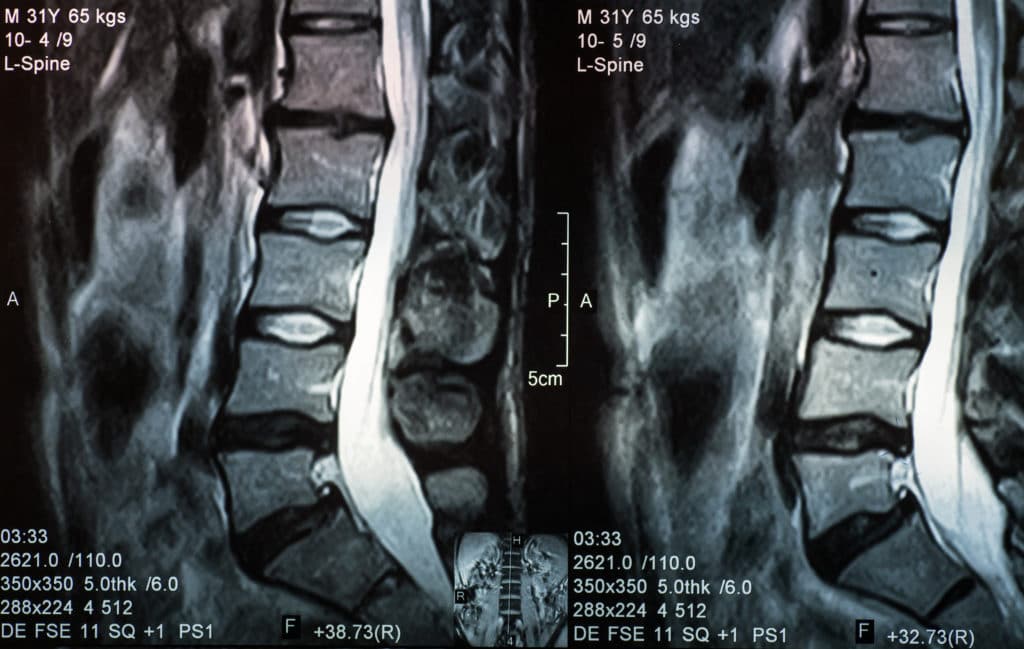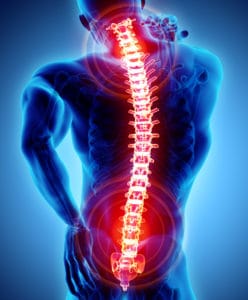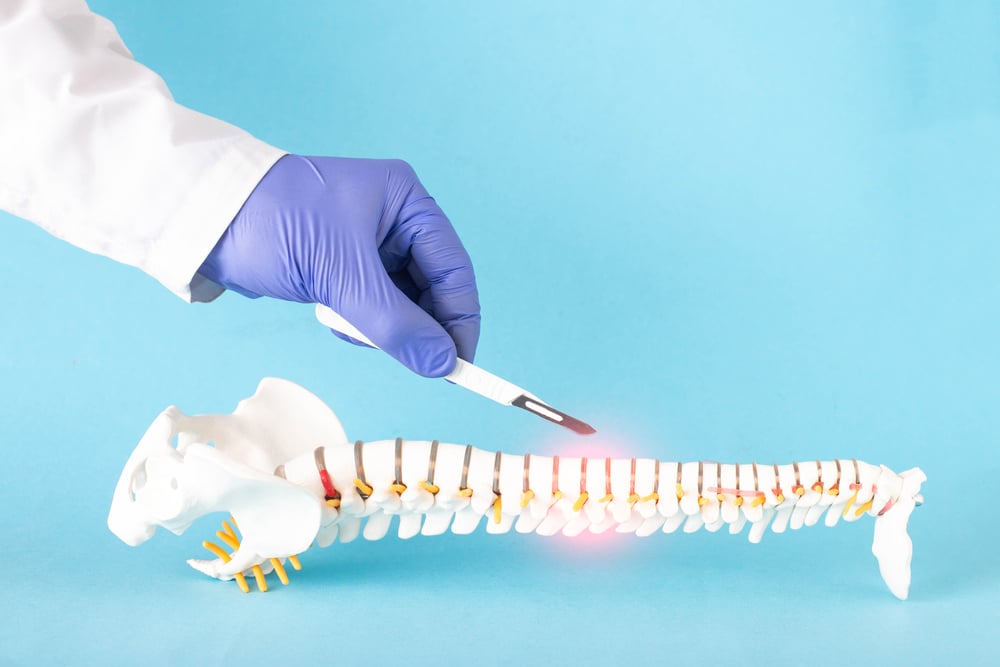When one of your spinal discs herniates, particularly in the mid to lower back, it can push outward and put pressure on the nearby nerves. This can create significant pain that often radiates down into the leg. This kind of herniation likely will not improve on its own, so Dr. Todd Albert can perform a surgical procedure called a microdiscectomy in NYC to relieve the pressure on the nerve and remove the source of the pain.
What Is A Microdiscectomy?
Microdiscectomy, also known as microdecompression, is one of the most common spine surgery procedures. The goal is to remove the portion of the herniated disc that is pressing on the nerve to relieve the pain and protect against permanent nerve damage. Microdecompression uses special instruments to allow the surgeon to make very small incisions.

This makes for a much quicker, less painful recovery. Microdiscectomy is very effective for relieving sciatica, more so than for relieving lower back pain.
What Is A Herniated Disc?
It helps to have an understanding of herniated discs. Between your vertebrae are rubbery cushions, the discs, which keep the bones apart. Discs have a softer gel in the interior encased in a tough outer skin. Sometimes an injury causes a tear to develop in the outer skin, and the inner gel pushes outward. When the gel pushes on an adjacent nerve, it results in pain, numbness, or weakness in an arm or leg. When the exiting nerve heads down to the leg, this pain is called sciatica, and the pain can be quite sharp. Over time, nerve compression can lead to weakness or loss of function.
Herniated Disc Symptoms
Besides the pain emanating from the herniated area, you may also experience the following:
- Tingling
- Numbness
- Muscle Spasms
- Weakness
The pain experienced as a result of a herniated disc is typically worsened by moving. Sudden motions like coughing or bending over can cause sharp shooting pains.
What Are The Benefits Of A Microdiscectomy?
Historically, surgical treatment for a herniated disc meant large incisions and a lengthy recovery. Microdiscectomy is an advanced surgical technique that is much less invasive. It is one of the most common spinal surgeries performed to alleviate back and leg pain, offering 90 to 95% of patients who undergo the procedure of significant pain relief.

Microdiscectomy Candidates In NYC
While disc herniation causes symptoms that may improve through conservative treatment, some patients experiencing pain for more than 6 weeks may benefit from surgery. Surgery may also be an option for those who have pain that limits their ability to function normally. While surgery is not always necessary, a microdiscectomy is considered an effective solution that can help relieve pain quickly. Dr. Albert will be able to determine if this procedure is right for you after evaluating your specific condition.
Dr. Todd Albert performs a microdiscectomy to decrease pain and allow you to regain normal movement and function. These are situations where this surgery could be the best solution:
- You have severe leg pain, numbness, and weakness that is impeding your daily activities.
- Your leg symptoms don’t respond to nonsurgical treatment.
- You are showing signs of weakness, loss of range of motion, and abnormal feelings, particularly in your leg and foot.
- The procedure can be an emergency if you suddenly are losing bowel or bladder control, if you have new weakness in usually both legs, and if you have new numbness or tingling in the buttocks, genital area, or legs.
The Microdiscectomy Procedure With Dr. Todd Albert
In a microdiscectomy, Dr. Albert employs different methods, depending on the situation, but the overall process is the same. First, with the patient lying on his or her stomach, a small incision is made in the area of the herniated disc. This is because the back muscles need to be moved. Since they run vertically, they can simply be lifted off the bony arch, called the lamina, of the spine and pushed to the side to expose the vertebrae.

Dr. Albert then removes a membrane over the nerve roots called the ligamentum flavum. At this point, it’s often necessary to remove a portion of the inside facet joint of the vertebra, both to provide access to the nerve root and to further relieve pressure on the area. The nerve root is then gently moved aside, and the disc material pushing on it is cut away. Only the herniated portion of the disc is removed, so this doesn’t affect the cushioning function of the disc. With the portion of the disc that was pushing on the nerve root removed, the pressure is immediately gone, and the nerve can begin healing and returning to normal, painless function. It takes time for the nerve root to heal, sometimes up to a year, but this usually involves a feeling of numbness, not pain. After microdiscectomy, patients feel almost immediate relief from the pain.
Patient Testimonial
"MY CERVICAL RADICULOPATHY TREATMENT
My name is Taya Derun; I’m 28 and was suffering for the past 13 years (would be exactly 14 this July 4th) following a severe automobile accident. I had daily debilitating axial neck pain with radiculopathy since the day following the accident. The only thing that somewhat alleviated it was chiropractic adjustment, which lasted until I awoke the following morning. On the average, the pain was an 8-10. MRIs & CT scans showed a severe herniation between C5/C6 + an osteophyte. I had a semi pain-free day once every 1-2 months. In order to live a normal life in terms of manageable pain, I would have needed to be adjusted by a chiropractor every morning. The pain decreased my quality of life and capabilities tremendously, especially after sitting, reading, running (or at least attempting to), and sleeping. I was scheduled for ACDF surgery twice before, but something didn’t feel quite right and I didn’t go through with them. To say that I’m thrilled to have met with and been operated on by Dr. Albert (artificial disc replacement) is a tremendous understatement. If waiting nearly 14 years in miserable chronic pain was what I needed in order to be healed by the most talented surgeon I could ever imagine, then it was all well worth it. Grateful doesn’t even begin to describe what I feel. Thank you Dr. Albert and HSS for giving me a second chance at a quality-filled life where I can now focus on treating patients and not being the patient."
Is The Microdiscectomy Surgery Painful?
Please keep in mind that pain is a very subjective experience, and one’s reaction to surgery is affected by a variety of factors, as mentioned above. It is not uncommon for a patient to experience “reminder” symptoms after surgery. These symptoms are often described as feeling similar to the patient’s preoperative symptoms but not as intense. This is very common as patients recover however if you are concerned please call the office to discuss your symptoms and concerns.
Preparing For Your Microdiscectomy In NYC
We ask that you refrain from taking any non-steroidal anti-inflammatory medicines 10 days before your surgery such as:
- Aspirin, Advil, & Aleve
- Herbal Supplements
- Vitamins E & K
- Fish oil
If you have a physician who recommends that you do not stop Aspirin prior to surgery please be sure to discuss this with our office.

What Is The Success Rate Of A Lumbar Microdiscectomy?
Multiple studies indicate that both short-term and long-term success for lumbar microdiscectomy is generally high. In one study, 84% of patients achieved excellent results. In a long-term study of nearly 40,000 cases, approximately 80% of patients achieved good to excellent results.
Recovery From Microdiscectomy Surgery
The first visit is approximately 2-weeks after surgery however if you have any questions or concerns please call the office. If we think we should see you in the office we will schedule an earlier appointment. Patients require a formalized outpatient physical therapy program after a microdiscectomy procedure. Most patients do not have sutures that require removal. There are internal sutures that will dissolve with time. There will also be steri-strips (white pieces of tape) over the incision that will either fall off or we will remove them from the office.
The average length of time out of work after a microdiscectomy surgery is between 1-4 weeks. Patients who perform labor-intensive jobs are more likely to be out of work closer to 4 weeks. For the first 2 weeks, your activity will be limited to walking. We encourage you to walk as much as you are comfortable. During this time you may go up and downstairs, with the use of a railing, and you may also sleep in a normal bed. There is a 5-pound lifting limit for the first 2 weeks. After two weeks you will be able to resume low-impact cardiovascular activities and increase the amount of weight you are lifting. Within a reasonable amount of time after surgery, you will have very few restrictions on your activities. Please be sure to discuss any specific questions with us in the office.
Can I Walk After My Microdiscectomy?
Not only can a patient walk after a microdiscectomy, but they are also encouraged to do so. Walking is one of the best ways to increase mobilization quickly after surgery, and mobilization is crucial to a more comfortable recovery. After surgery, patients may be advised to begin walking short distances as soon as possible. This will eventually be complemented by strengthening and conditioning within the realm of physical therapy. Together, the movements of walking and prescribed exercises support prompt and efficient healing.
Is It Normal To Have Leg Pain After Microdiscectomy?

Does Numbness Go Away After Microdiscectomy?
Most patients feel significant relief from leg pain immediately after microdiscectomy surgery. Weakness, numbness, and other neurological symptoms, however, may improve more gradually. It may take weeks or months for the nerve root to heal to the point at which numbness and weakness subside.
How Soon After My Microdiscectomy Can I Start Physical Therapy?
Physical therapy may be prescribed to begin within the first 3 weeks after microdiscectomy surgery. The total time in physical therapy that is necessary for recovery can vary. Generally, most patients can achieve significant improvement within 6 to 8 weeks of consistent rehabilitation after their procedure.
Risks & Complications With Microdiscectomy Surgery
The typical risks of surgery such as infection and blood loss apply, but more specific complications are:
- Pain can return.
- A disc can re-herniate.
- The spinal cord, nerves, and blood vessels can be injured.
These issues are very rare, and Dr. Albert has very high success rates with this procedure.
Rehabilitation Process Following Microdiscectomy

After a microdiscectomy, a structured rehabilitation program is crucial for optimal recovery. Initially, you are advised to rest and avoid strenuous activities to allow healing. Gradually, under professional guidance, gentle exercises are introduced to improve mobility and strengthen your back muscles. Physical therapy often plays a significant role, focusing on posture correction, flexibility, and core strengthening to support the spine and prevent future issues. Adhering to the recommended rehabilitation plan can enhance recovery outcomes and reduce the risk of recurrent disc herniation.
Cost of Microdiscectomy
The cost of a microdiscectomy can vary significantly. While it's challenging to provide an exact figure without a personalized consultation, you should be aware that insurance usually covers a portion of the procedure. Dr. Albert accepts insurance from Blue Cross Blue Shield, Cigna, and Oxford/United Healthcare; he is considered out of network for most other insurance providers. Additionally, financing options may be available to help manage out-of-pocket expenses. It's advisable to consult with your insurance provider and the medical facility's billing department to obtain a detailed estimate tailored to your situation.
Alternative Treatments for Herniated Spinal Disc
Before considering surgery, several non-surgical treatments are available for managing a herniated spinal disc:
- Physical Therapy: Customized exercises can alleviate pain, improve function, and strengthen the muscles supporting the spine.
- Medications: Nonsteroidal anti-inflammatory drugs (NSAIDs) may be prescribed to reduce pain and inflammation.
- Epidural Steroid Injections: These can provide temporary relief by reducing inflammation around the affected nerves.
- Chiropractic Care: Spinal manipulation may offer relief for some patients, though it's essential to consult with a healthcare provider to determine suitability.
- Lifestyle Modifications: Weight management, proper ergonomics, and avoiding activities that exacerbate symptoms can aid in recovery.
It's important to note that while these treatments can be effective for many people, their success varies based on the severity of the herniation and individual patient factors. A thorough evaluation by a spine specialist is recommended to determine the most appropriate treatment plan for you.
How Safe Is Microdiscectomy?
Microdiscectomy is a minimally invasive procedure widely regarded as safe and effective for addressing herniated discs. The advanced surgical techniques and smaller incisions used in this procedure significantly reduce risks compared to traditional open surgery. Complications are rare but can include infection, nerve damage, or recurrence of the herniated disc. Choosing an experienced spine surgeon like Dr. Albert and adhering to pre- and post-operative care guidelines can further minimize your risks and enhance outcomes. You should experience a substantial reduction in pain and improved mobility after surgery, making microdiscectomy a reliable option for herniated disc treatment.
Why Should I Choose Dr. Albert to Perform Microdiscectomy?
Dr. Todd J. Albert is a leading expert in spine surgery, bringing years of specialized experience and a patient-centered approach to every procedure. His commitment to using the latest minimally invasive techniques ensures that patients receive the most advanced care with shorter recovery times. Dr. Albert is known for his meticulous attention to detail, excellent surgical outcomes, and dedication to tailoring treatment plans to each patient’s unique needs. He is the winner of the prestigious Nicolas Andry Award for his lifetime of scientific research and contributions to the field of orthopedic spine surgery in addition to being the recipient of many other honors and awards.
Schedule A Consultation
If you are suffering from a herniated lumbar disc and are looking for a surgical pain-relief option, schedule a consultation with Dr. Todd Albert to discuss your eligibility for undergoing a microdiscectomy in NYC by Calling 212-606-1004 today.


